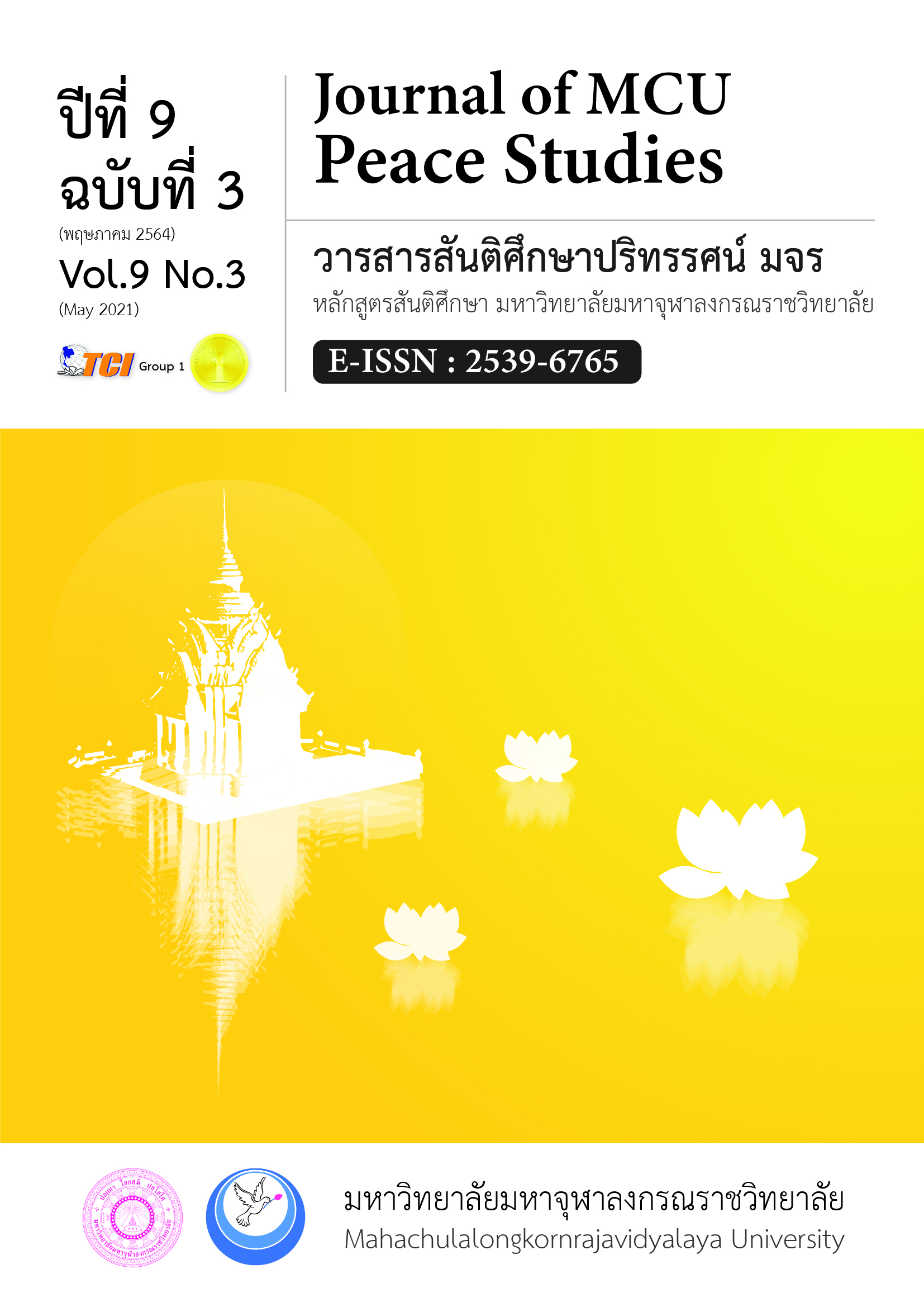พัฒนาตัวชี้วัดและวัดระดับสันติภาพในสังคมไทย พ.ศ.2563
Main Article Content
บทคัดย่อ
การวัดระดับสันติภาพในโลกทำให้ได้ทราบข้อมูลเปรียบเทียบในระดับประเทศ แต่ยังขาดข้อมูลลงลึกถึงระดับภูมิภาคหรือจังหวัด และบริบทของประเทศไทย ทั้งในด้านเศรษฐกิจ สังคม วัฒนธรรมและการเมืองบทความวิจัยเรื่องนี้ มีวัตถุประสงค์เพื่อ 1) พัฒนาดัชนีและตัวชี้วัดด้านสันติภาพที่เหมาะสมกับบริบทของสังคมไทย และ 2) วัดระดับสันติภาพในสังคมไทยเพื่อนำไปสู่ข้อเสนอแนะในการสร้างสันติภาพให้เกิดขึ้น การศึกษาครั้งนี้ เป็นการดำเนินในระยะที่ 2 ปี พ.ศ.2563 (เก็บข้อมูลปี 2562) เป็นการวิจัยเชิงปริมาณและคุณภาพ มีการจัดทำตัวชี้วัดทั้งในระดับประเทศและระดับจังหวัด แหล่งข้อมูลที่นำมาใช้ มีทั้งข้อมูลสถิติ จากหน่วยงานที่เกี่ยวข้องที่ได้จัดเก็บข้อมูลอย่างต่อเนื่อง และข้อมูลจากการสำรวจความคิดเห็นทั่วประเทศจัดเก็บข้อมูลโดยสำนักงานสถิติแห่งชาติจำนวนทั้งสิ้น 33,420 คน คำนวณค่าดัชนีตามกรอบของ Organization for Economic Co-operation and Development (OECD) และ Ebert and Welsh และนำเสนอข้อมูลระดับสันติภาพในสังคมไทยทั้งในระดับประเทศและระดับจังหวัด ผลการวิจัยพบว่า จากผลการศึกษาเปรียบเทียบระหว่างปี 2560 กับ 2562 ระดับดัชนีสันติภาพ ของประเทศไทยปี พ.ศ. 2560 มีค่าเท่ากับ 3.42 คะแนน ซึ่งมีระดับดัชนีสันติภาพสูงกว่าปี 2562 ที่ได้ระดับดัชนีสันติภาพเท่ากับ 3.36 สำหรับการคำนวณระดับสันติภาพในภาพรวมระดับจังหวัดสามารถแบ่งกลุ่มจังหวัดตามระดับสันติภาพได้เป็น 5 กลุ่ม ที่มีสันติภาพสูงสุดและสันติภาพต่ำสุด ผลการวิจัยนี้สามารถนำไปใช้ในการเรียนรู้ร่วมกันในสถาบันการศึกษา ประกอบกับการกำหนดนโยบายของหน่วยงานที่เกี่ยวข้องในด้านสันติภาพ
Article Details
ทัศนะและความคิดเห็นที่ปรากฏในบทความในวารสาร ถือเป็นความรับผิดชอบของผู้เขียนบทความนั้น และไม่ถือเป็นทัศนะและความรับผิดชอบของกองบรรณาธิการ ยินยอมว่าบทความเป็นลิขสิทธิ์ของวารสาร
เอกสารอ้างอิง
Department of Economic and Social Affairs of United Nations. (2020). World Social Report 2020. Retrieved July 12, 2020, from https://www.un.org/development/desa/publications/world-social-report-2020.html
Department of State United States of America. (2019). Trafficking in Persons Report. Retrieved July 15, 2020, from http://www.state.gov/wpcontent/uploads/2019/06/2019-Trafficking-in-Persons-Report.pdf
Ebert, U., & Welsch, H. (2004). Meaningful environmental indices: A Social Choice Approach. Journal of Environmental Economics and Management, 47(2), 270-283.
Freedom House. (2020). Freedom in the World. Retrieved August 2, 20202, from https://freedomhouse.org/sites/default/files/2020-02/FIW_2020_REPORT_BOOKLET_Final.pdf
Galtung, J. (1996). Peace By Peaceful means: Peace and Conflict, Development and Civilization. Oslo: International Peace Research Institute.
Institute for Economics and Peace. (2019). Covid19 and Peace. Retrieved July 23, 2020, from http://visionofhumanity.org/app/uploads/2020/06/COVID19-and-Peaceweb.pdf
________. (2019). Global Peace Index 2019: Measuring Peace in a Complex World. Retrieved July 23, 2020, from http://visionofhumanity.org/app/uploads/2019/07/GPI2019web.pdf
________. (2019). Positive Peace Report 2019: Analysing the Factors that Sustain Peace.Retrieved July 23, 2020, from http://visionfhumanity.org/app/uploads/2019/10/PPR-2019-web.pdf
________. (2019). Global Terrorism Index 2019: Measuring the Impact of Terrorism. Retrieved July 23, 2020, from http://visionofhumanity.org/app/uploads/2019/11/GTI2019web.pdf
Institute for Justice and Reconciliation. (2019). SA Reconciliation Barometer Survey. Retrieved July 23, 2020, from https://www.ijr.org.za/portfolio-items/sa-reconciliationbarometer-2019
Inter-Agency and Expert Group. (2017). Report of the Inter-Agency and Expert Group on Sustainable Development Goal Indicators (Revised List of Global Sustainable Development Goal Indicators). Retrieved August 5, 20202, from https://unstats.un.org/sdgs/indicators/Official%20Revised%20List%20of%20global%20SDG%20indicators.pdf
King Prajadhipok's Institute and National Statistical Office. (2019). Public Opinion Survey Report on Satisfaction with Public Service and Operation of Various Agencies B.E. 2562. Bangkok: Research and Development Division.
National Statistical Office. (2015). Thailand Poverty Maps Whole Kingdom. Bangkok: National Statistical Office.
________. (2019). The Labor Force Survey Whole Kingdom Between B.E. 2560 – 2562. Bangkok: National Statistical Office.
Office of the National Economic and Social Development Council. (2019). Human Achievement Index of Year 2562. Bangkok: Office of the National Economic and Social Development Council.
Organisation for Economic Co-operation and Development. (2008). Handbook on Constructing Composite Indicators: Methodology and User Guide. Paris: OECD Publishing.
Ramsbotham, O., Miall, H., & Woodhouse, T. (2011). Contemporary Conflict Resolution. UK: Polity Press.
The Legatum Institute Foundation. (2019). The Legatum Prosperity IndexTM: A Tool for Transformation 2019. Retrieved August 5, 2020, from https://www.prosperity.com/download_file/view_inline/3690
The World Justice Project. (2020). The World Justice Project Rule of Law Index 2020. Retrieved August 9, 2020, from https://worldjusticeproject.org/sites/default/files/documents/WJP-ROLI-2020-Online_0.pd


